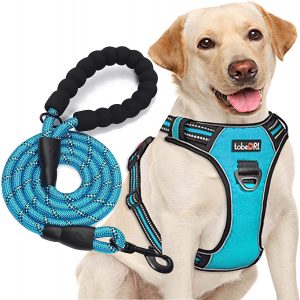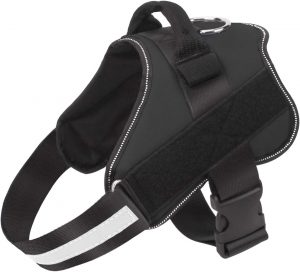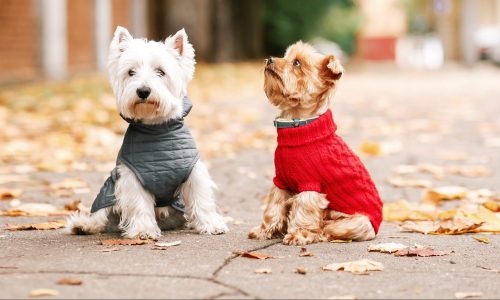The Best Large Dog Harness
We looked at the top 9 Large Dog Harnesses and dug through the reviews from 29 of the most popular review sites including and more. The result is a ranking of the best Large Dog Harnesses.

Our Review Process
Don't Waste Your Money is focused on helping you make the best purchasing decision. Our team of experts spends hundreds of hours analyzing, testing, and researching products so you don't have to. Learn more.
Our Picks For The Top Large Dog Harnesses
- 1. tobeDRI Nylon No Choke Large Dog Harness
- 2. BARKBAY Lightweight Anti-Rip Large Dog Harness
- 3. rabbitgoo Breathable Cushioned Large Dog Harness
- 4. Auroth Army Breathable Mesh Large Dog Harness
- 5. WINSEE Snap Buckle Nylon Large Dog Harness
- 6. Eagloo No Pull Front Clip Large Dog Harness
- 7. Bolux Daily Service Large Dog Harness
- 8. BABYLTRL Choke-Free Security Large Dog Harness Vest
- 9. PoyPet Non-Toxic Mesh Large Dog Harness
A perfect fit is what you can expect from this large dog harness, which is equipped with four size adjusters. It's constructed using nylon webbing for strength and durability and a mesh inner lining to keep it breathable. You can even get the harness in one of 10 different colors.
Strong and DurableThe reflective stitching on this large dog harness adds a layer of nighttime security.
Keep your pet safe during morning and evening strolls using this large dog harness. It features adjustments at four different points and offers an easy control handle, as well as an anti-pull front clip. Comfort is also at the top of the company's priority list, which is why the harness is made with anti-chafe padding.
Fully AdjustableThis large dog harness is best used on dogs with a chest girth between 27 and 32 inches.
This large dog harness is designed with the safety of the dog in mind on multiple levels. It distributes pressure evenly when pulled from either leash attachment on the chest or back, and the entire harness is reflective for night walks. It comes in a variety of sizes and attractive colors.
Safety PickThis harness is easy to adjust and distributes pressure for maximum comfort.
Whether you're training a service dog or taking your best friend for a walk, this large dog harness has you covered. It features two adjustable straps and two quick-release buckles for easy of use. The harness itself is constructed from a 900D nylon that is extremely strong and reliable.
Multiple Color OptionsYou'll find this large dog harness is available in 13 fun colors, including pink camo, Army yellow and denim blue.
Buying Guide
Most of the time, dogs are easy to love. Feeling their head on our laps is instantly relaxing, and their enthusiasm is infectious when it’s playtime around the house.
But that enthusiasm can be a little exhausting — and potentially dangerous — when it comes time to walk especially willful dogs. That goes double for larger breeds, which is why owners might want to ditch that old-fashioned collar in favor of a harness.
Why a harness? There are a lot of reasons why dog owners (and most dog trainers) prefer these more full-bodied restraints when it’s time to take a walk. The main advantage, though, is safety. When you try to hold back an excitable dog, your dog collar pulls on one spot and one spot only: Their windpipe. Some dogs may take the hint quickly that such pulling will be painful, but some will not — and it’s never a good idea to associate punishment with a necessary daily routine.
When your dog is in a well-designed harness, the force of your pull typically gets distributed along the chest and back, allowing you to control him or her without hurting them. That’s because unlike a collar, a harness might go on over the midsection and front legs in a variety of ways depending on the design. As a bonus, many harnesses are fitted by slipping the paws into openings and buckling or strapping it on over the back. That can be a godsend for pups who don’t like the sensation of a collar being squeezed on over their ears.
There are actually a variety of harness types, each one with their strengths depending on your dog’s size and temperament. The most common kind is a vest harness, which is made of some kind of mesh or mildly stretchable material. It goes on much like a piece of clothing, fitting over the front part of the dog’s chest and front legs. It’s generally the most comfortable style, and the wider distribution of material means that it won’t chafe as much on the legs and chest. Depending on the placement of the leash, it may not be the best for dogs that pull frequently, but it will still be miles better than a standard collar.
There’s also a webbed harness, which tends to be less expensive. This is basically just a series of straps that distribute the weight of your leash pull in much the same way as a vest harness. Depending on the design, it may be easier to put on your dog and is somewhat less restrictive, but you’ll still probably want to take it off between walks.
A less common option is the head halter, which doesn’t go on over the dog’s midsection but is placed over the neck while another strap goes over the top of the nose. Some may allow you to actually muzzle your pet. In either case these harnesses are an option for people with especially unruly or excitable dogs, or owners who don’t have the strength to pull them. The idea is that dogs don’t have as much strength in their neck, so it takes less force to hold them back. You may want to consult with a vet or other pet expert before buying one, though. Some dogs may not respond well to the fitting, and improper use can injure the animal.
Harnesses have a particular advantage in that they allow more places for the leash to attach. With vest or webbed harnesses, your main options will be leash rings on the back or chest. Many will have both.
Clipping the leash on the back will be the most common way to go for many dog owners. It’s easy to attach, and it seems intuitive since the leash will be out of the way if your dog walks beside you or ahead of you. For most dogs, this will indeed work just fine: If your dog pulls, the weight will distribute any pressure evenly, lessening the chance of chafing.
For some dogs, though, a front-leading clip that attaches at the chest can work wonders. Many dogs have an instinct to pull against any resistance, and a front lead works against that by simply encouraging the dog to turn. This type of lead doesn’t work for every breed, and might take a bit of getting used to. There’s a higher chance of the leash getting tangled in the front legs, for example.
Finally, consider both the durability of the material and how easily you can adjust it to fit your dog. That goes double if your pet is likely to grow a few sizes. You’ll use your harness several times a day, after all. Make sure it will last.
Why we recommend these large dog harnesses?
Products Considered
Products Analyzed
Expert Reviews Included
User Opinions Analyzed
Our experts reviewed the top 9 Large Dog Harnesses and also dug through the reviews from 29 of the most popular review sites including and more. The result is a ranking of the best of the best Large Dog Harnesses.
DWYM is your trusted roduct review source. Our team reviews thousands of product reviews from the trusted top experts and combines them into one easy-to-understand score. Learn more.
The Best Bang For Your Buck
rabbitgoo Breathable Cushioned Large Dog Harness
Key Takeawy
This large dog harness is designed with the safety of the dog in mind on multiple levels. It distributes pressure evenly when pulled from either leash attachment on the chest or back, and the entire harness is reflective for night walks. It comes in a variety of sizes and attractive colors.
What other experts liked
What other experts didn't like
What to Look For
You can choose a great harness, but let’s face it: Your dog is the one who will decide if it’s right for them. If you have a pet that’s skittish about restraints, introduce them to it slowly, allowing them to smell it and perhaps even breaking out a treat or two the first few times that you put it on. Before you take your dog walking in their new harness, make sure that the fit is snug but not too tight. A good harness is supposed to spare your dog any chafing or choking, but a loose fit can cause friction all on its own.
More to Explore
The first dog harnesses were likely used by the Inuit people of Northern Canada, who were practicing dog sledding as early as 1980 B.C. Dog sleds were an effective way to get around the harsh snowy terrain, and are still in use today – most famously in the Iditarod, a 1000-mile sled race from Anchorage to Nome, Alaska. It commemorates a famous run in which sled dogs were used to transport life-saving antitoxin during an outbreak of diptheria.






















